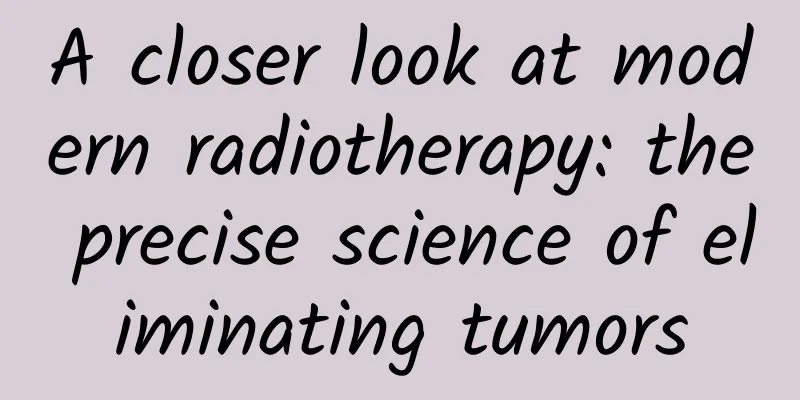A closer look at modern radiotherapy: the precise science of eliminating tumors

|
Radiotherapy, as an important means of cancer treatment, has become part of the treatment plan for about 70% of cancer patients. Despite its critical role in tumor treatment, many patients still have doubts and "misunderstandings" about radiotherapy before receiving it. Common concerns include: "The doctor recommended that I undergo radiotherapy. Is it because my condition has reached an advanced stage?" or "Does radiotherapy involve radiation? Will the side effects be severe?" Some people even worry that they may lose their hair after treatment, which will affect their normal communication. But what exactly is radiotherapy? How does it use radiation to destroy cancer cells? How are tumors removed? Today, let us unveil the mystery of radiotherapy and learn about this precise scientific treatment method. Most people are familiar with surgical treatment of cancer, which is to remove the tumor through surgery. However, radiotherapy, a treatment method with a high-tech aura, often confuses people. Radiotherapy uses high-energy rays, such as X-rays, gamma rays, beta rays, high-energy electron beams, protons or heavy ions, to irradiate tumors. These rays can damage the DNA in cells, so that cancer cells lose the ability to divide and replicate, thereby achieving the purpose of shrinking or eliminating tumors. However, while destroying cancer cells, radiation can also damage normal organ cells. How can this seemingly contradictory problem be resolved? Radiotherapy radiation is different from nuclear radiation. Radiotherapy radiation is precise and controllable. During radiotherapy, radiation is only generated when the machine is turned on and can be precisely controlled with an accuracy of less than 1mm, thereby protecting the function of normal tissues and organs to the greatest extent possible. The secret to radiotherapy's ability to accurately eliminate cancer cells lies in two aspects: first, it takes advantage of the difference in repair speed between cancer cells and normal cells; second, the radiation dose given to the tumor is much greater than the radiation dose to normal organs. As radiotherapy technology continues to develop, scientists have discovered that some types of cancer can be treated with radiotherapy because cancer cells divide quickly, are more sensitive to radiation, and are not as fast at repairing as normal cells. Scientists have also discovered that if a single dose is not enough to kill cancer cells, they may repair and revive. Therefore, modern radiotherapy technology divides the radiation dose that kills tumors into multiple doses, taking advantage of the fact that normal cells repair faster than cancer cells, and continuously accumulating the killing effect, ultimately eliminating tumor cells while protecting normal organs. One of the two tricks of radiotherapy is to irradiate the tumor in fractions. For example, if the lethal dose of the tumor is 6000cGy, then this 6000cGy dose is dispersed into 30 irradiations, each irradiation is 200cGy. In this way, the tumor still receives a lethal dose, but because normal organs have a strong recovery ability, the radiation exposure is greatly reduced, thus ensuring the function and integrity of normal organs. Another trick is dose distribution and radiation focusing. The radiotherapy accelerator rotates around the patient's body and irradiates the tumor from different directions. The dose in each direction is not large, and the dose to normal cells involved is also small, but the radiation from all directions converges at the center of the tumor, so that the tumor receives a high dose of radiation. When high-energy rays destroy cancer cells and render them inactive, they are usually metabolized through blood vessels to the intestines or kidneys and eventually excreted from the body. For example, a lung tumor that has been radiotherapy will disappear on a CT scan after a period of treatment because the lungs have rich blood supply. In summary, radiotherapy is a precise science that uses precise control and fractionated irradiation of radiation, as well as dose sharing and radiation focusing techniques to precisely eliminate cancer cells while protecting normal organs to the greatest extent possible. This not only reflects the progress of modern medical technology, but also provides cancer patients with a more effective and safer treatment option. |
<<: Calcium, Vitamin D and Physical and Mental Health
>>: Adequate dietary phosphorus intake may reduce the risk of diabetes in Chinese adults
Recommend
How to maintain the uterus and ovaries
Everyone hopes that their body can be particularl...
What is the reason for small pits on the nails of pregnant women?
Presumably, for women, pregnancy is both a happy ...
【Health Lecture】"Knee" related
In order to ensure the popularization effect of l...
What causes delayed menstruation after sex?
Delayed menstruation is generally a normal phenom...
Will my belly swell during contractions?
During the last few months of pregnancy, you may ...
What are the symptoms of ovulation?
Women have a certain ovulation period every month...
Green discharge from the vagina
For women, the secretions from the lower body are...
What to do if you don't have eggs? How to improve the quality of eggs
In this era, due to our unhealthy diet and irregu...
Is estrogen testing a blood test?
Is the estrogen test a blood test? Female estroge...
The wisdom tooth is inflamed again. Should I remove it or not?
Have you ever heard that removing wisdom teeth ca...
Pain after breast emptying
If a woman experiences a tingling sensation after...
If you are more afraid of heat than the people around you, you should check your thyroid gland!
How hard is summer? Taking one more step outside ...
What period does the 5th day of menstruation belong to?
During menstruation, girls should be aware of the...
What seasonings should be added when cooking noodles? How to store dried noodles without insects
Dried noodles are made by adding salt, alkali and...
Qingbi Hall: Do rhinitis exercises every day and say goodbye to nasal congestion and headaches!
During the onset of rhinitis, nasal congestion, i...









